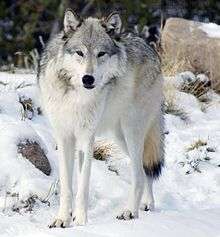Northwestern wolf
| Northwestern wolf Canis lupus occidentalis Temporal range: Late Pleistocene - recent | |
|---|---|
 | |
| C. l. occidentalis at the Grizzly and Wolf Discovery Center at West Yellowstone, Montana. | |
| Scientific classification | |
| Kingdom: | Animalia |
| Phylum: | Chordata |
| Class: | Mammalia |
| Order: | Carnivora |
| Family: | Canidae |
| Genus: | Canis |
| Species: | C. lupus |
| Subspecies: | C. l. occidentalis |
| Trinomial name | |
| Canis lupus occidentalis Richardson, 1829 | |
 | |
| C. l. occidentalis range (green) | |
| Synonyms | |
The northwestern wolf, Canis lupus occidentalis, also known as the Mackenzie Valley wolf, Alaskan timber wolf,[3] Canadian timber wolf, or northern timber wolf,[1] is a subspecies of gray wolf in western North America. It ranges from Alaska, the upper Mackenzie River Valley; southward into the Canadian provinces of British Columbia, Alberta, and Saskatchewan as well as the Northwestern United States.[3]
Along with C. l. nubilus, C. l. occidentalis is the most widespread member of the five gray wolf subspecies in North America, with at least six different synonyms.[1]
The subspecies was first written of by Scottish naturalist Sir John Richardson in 1829. He chose to give it the name occidentalis in reference to its geographic location rather than label it by its color, as it was too variable to warrant such.[4] Phylogenetic analyses of North American gray wolves show that there are three clades corresponding to C. l. occidentalis, C. l. nubilus and C. l. baileyi, each one representing a separate invasion into North America from distinct Eurasian ancestors. C. l. occidentalis, the most northwestern subspecies, is descended from the last gray wolves to colonize North America. It likely crossed into North America through the Bering land bridge after the last ice age, displacing C. l. nubilus populations as it advanced, a process which has continued till present times.[1]
Northwestern wolves have been responsible for a few notable attacks on humans, with at least two fatal attacks in the 21st century in which both victims were partially eaten: in 2005, a young man was killed in Points North Landing, Saskatchewan, Canada[5] while in 2010, a young woman was killed while jogging near Chignik Lake on the Alaska Peninsula.[6]
Description
Northwestern wolves are one of the largest subspecies of wolves with grown males weighing between 105 lb (48 kg) and 135 lb (61 kg) in British Columbia, Canada.[7] The heaviest recorded specimen was killed on 70 Mile River in east-central Alaska on July 12, 1939 and weighed 79.4 kilograms (175 lb).[8] Sir John Richardson described the northwestern wolf as having a more robust build than the European wolf, with a larger, rounder head and a thicker, more obtuse muzzle. Its ears are also shorter, and its fur bushier.[4]
Reintroduction
In Yellowstone National Park, artificially relocated northwestern wolves have been well-documented feeding on elk. They usually stampede the herd using pack teamwork to separate the younger elk from the adults. They also will charge young calves separated from their parents. Winter-weakened or sick elk also play an important part of Yellowstone wolf diets and it is estimated that over 50 percent of winter-weakened or sick elk in Yellowstone are killed by wolves. Of these, about 12 percent of carcasses were scavenged by other predators including; ravens, bald eagles, black bears, grizzly bears, and coyotes.[9] In the same national park, wolves also prey on bison, though such attacks usually involve sick animals or calves, as bison can easily kill wolves with their hooves.[10]
References
- 1 2 3 4 5 6 7 Chambers SM, Fain SR, Fazio B, Amaral M (2012). "An account of the taxonomy of North American wolves from morphological and genetic analyses". North American Fauna. 77: 1–67. doi:10.3996/nafa.77.0001. Retrieved 2013-07-02.
- 1 2 Wozencraft, W.C. (2005). "Order Carnivora". In Wilson, D.E.; Reeder, D.M. Mammal Species of the World: A Taxonomic and Geographic Reference (3rd ed.). Johns Hopkins University Press. ISBN 978-0-8018-8221-0. OCLC 62265494.
- 1 2 Mech, L. David (1981), The Wolf: The Ecology and Behaviour of an Endangered Species, University of Minnesota Press, p. 352, ISBN 0-8166-1026-6
- 1 2 Richardson, J. (1829) Fauna boreali-americana, or, The zoology of the northern parts of British America, London : J. Murray [etc.], pp. 60-65
- ↑ McNay, M. E. (2007) "A Review of Evidence and Findings Related to the Death of Kenton Carnegie on 8 November 2005 Near Points North, Saskatchewan". Alaska Department of Fish and Game, Fairbanks, Alaska.
- ↑ Butler, L., B. Dale, K. Beckmen, and S. Farley. 2011.Findings Related to the March 2010 Fatal Wolf Attack near Chignik Lake, Alaska. Wildlife Special Publication, ADF&G/DWC/WSP-2011-2. Palmer, Alaska.
- ↑ Table listing the 1996 Northwestern wolves introduced into Idaho. Forwolves.org (2002-11-01). Retrieved on 2012-12-29.
- ↑ Lopez, Barry H. (1978). Of Wolves and Men. J. M. Dent and Sons Limited. p. 18. ISBN 0-7432-4936-4.
- ↑ "Yellowstone Elk". National Park Service.
- ↑ "Wolf -Bison Interactions in Yellowstone National Park". University of Nebraska.
External links
| Wikispecies has information related to: Canis lupus occidentalis |
| Wikimedia Commons has media related to Canis lupus occidentalis. |